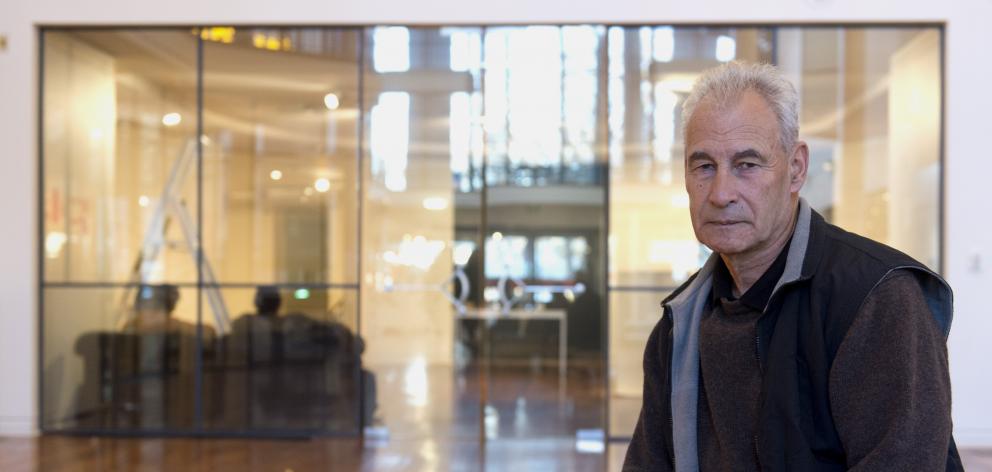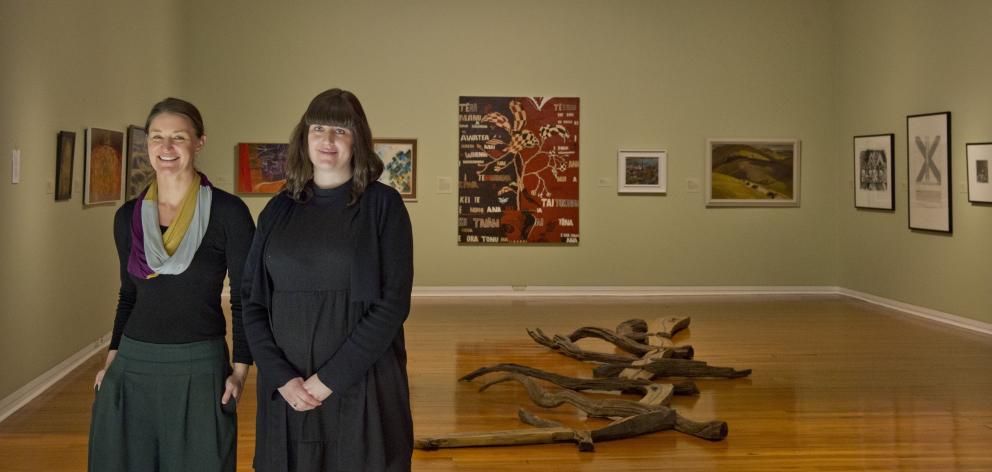
Growing up in Omarama, Ross Hemera visited the rock drawings along the Ahuriri River.
"I look back and think it is amazing that I was brought up with our tipuna’s [ancestor’s] art work right there to go and visit."
Little did he know that decades later they would be inspiring the work he is creating on the walls of Dunedin Public Art Gallery’s ground floor gallery.
"A lot of that imagery is my basic reference point. Primarily, the stories I’m telling are all about whakapapa, all to do with genealogy."
Hemera, who is known for his mixed-media sculptures including glass windows and globes in Queenstown’s Post Office precinct, believes the way his ancestors thought of the rock drawings in the limestone cliffs of North Otago and South Canterbury is not that different from how he thinks of them.
"It’s about expressing in visual terms a particular lineage."
His work, which will great visitors as they enter the gallery, will also reference the three runanga of Otago — Otakou, Puketeraki and Moeraki.
"We keep tying and connecting things, so while you think about one thing, you are thinking about another. They are the threads that keep us connected to our history and to our tikanga and to our communities."
Hemera, who is now based in Tauranga and retired from his position as professor of Maori art and design at Massey University’s College of Creative Arts, is part of Paemanu, the Ngai Tahu contemporary Maori artists’ trust with Areta Wilkinson, Rachael Rakena, Simon Kaan, Nathan Pohio, Rongomaiaia Te Whaiti, Vicki Lenihan and Lonnie Hutchinson.
"Ngai Tahu traditions are very much at the centre of what we do as a visual artists group."
The network, which works with art institutions and organisations on projects and exhibitions, began a conversation with the Dunedin Public Art Gallery two years ago.
"We have a strong sense of connection between our artists and others who support what we are doing."
The conversation culminated in the placing of three kohatu mauri in the gallery foyer.
"That signalled our arrival in the gallery."
It "flows" into the work that Hemera is creating for the exhibition, "Hurahia Ana Ka Whetu, Unveiling the Stars", which also features work from the gallery’s collection.
"It sets a way of thinking about this new display the gallery is putting on from the permanent collection."
Curator Lucy Hammonds says the process required the gallery to look at its identity and history and how it could share its space.
"The gallery has undergone ebbs and flows of different directions over that history."

"We found our way through the process of making an exhibition where both voices were given space."
It has resulted in a very different type of exhibition.
"It is a conversation which evolved into a practice or a way of making something differently. That to me is what genuinely working in partnership actually looks like."
They have developed, with Paemanu, a collective way of working.
"It’s a different cycle, a different way of working, which this exhibition is part of."
The exhibition still celebrates the story of the art collection, but it is the way it has come together and the way it is presented that is slightly different, she says.
Some of the works have not been exhibited before and others will be seen in a new light.
One of the important aspects of the exhibition is giving space for many people to author parts of the exhibition from the exhibition text to the individual work’s labels.
"People will notice as they move through the exhibition that there are different voices within the different pieces of writing they will encounter. The tone shifts throughout the exhibition, which is an intentional thing."
It will be a continuing part of how the exhibition will develop over the year it is open.
Hammonds says that the approach they have taken is one more usually expected with contemporary exhibitions.
"It’s not such a common way of working with a historic collection, which is quite a liberating thing.
"It reminds us the historic collection is not fixed or locked into a particular narrative.
"You can work together to find different ways of reading the collection."
Hemera says the group wanted to bring what is important to it into the space and offer them as ways of thinking — "Ways the space can be interpreted, how the space can be organised, how the building can be thought about, the land that it stands on and the history of this place, Otepoti Dunedin and Otago, Otakou".
"That it is a place I can see my tipuna, my ancestors. That this is a place where those things are treasured, along with the things that are treasured and valued and thought of as really, really significant. Emblems of identity, from all time periods in the name of art. Those are the things that are in the back of my mind at the same time as being an artist."
The process has given both parties time to think and enjoy what they are doing.
"We’re learning from each other about who we are. What we are and what art actually means — what the value of art actually is."
Being invited to occupy space in the gallery is "really significant and really important to us", Hemera says.
"We do it a little bit differently. We make our mahi toi, our art, toi, in different ways and value art in different ways. We see art as part of our whole world, so we bring that world with us. It is about ensuring that our hapu, our whanau are with us on that journey."
Artists take that responsibility "very seriously", he says.
"The gallery does the same with the collection. We all do that. It is the list of art works that are increased and enhanced by that overlay."
Hemera’s work for the exhibition introduces a particular whakaahua, image or essence that is identifiably Ngai Tahu.
"As an artist, I refer to the toi, to the imagery laid down by our ancestors and most of that is found in our rock drawings.
"I guess what I’m doing here is ensuring that I’m using the right, the correct, imagery and reference point to talk about Ngai Tahu culture through art."
He likens his drawings on the curved gallery wall to what his ancestors did in their drawings on limestone.
"I think that is what the tipuna did: take the opportunity to infuse themselves into the landscape and so that to me is quite a powerful thing to think about and to be part of."
"I feel that I am putting myself in the walls. That is pretty special to have an opportunity to do that."
Hammond says it is a big and important step, institutionally, for the gallery to step into a space where it can uphold and celebrate its history and also expand that story at the same time.
"That’s a very important thing and has resulted in an exhibition that is going to be quite spectacular in how it casts new light on things that are well loved and bring out some things that have never been out before.
"There is a much higher prominence of toi Maori in this exhibition, which was a strong part of the conversation with Paemanu. That we can use the collection to look at Maori art and expand it out to Maori and Pacific art within the collection to understand what that story looks like in this collection and celebrate those artists."
The exhibition includes works by all Maori artists in the collection and from the Pacific region.
"It’s been a really exciting and enriching process."
The exhibition
"Hurahia Ana Ka Whetu, Unveiling the Stars", Dunedin Public Art Gallery, from Saturday until July 3, 2022.
Free floortalk: Members of Paemanu Ngai Tahu Contemporary Visutal Arts and DPAG curators talk about the exhibition, Saturday, 11am.
Lunchtime soundbite: DPAG’s Creative New Zealand intern Piupiu Maya Turei takes a guided tour of the exhibition, July 7, 12.15pm.












